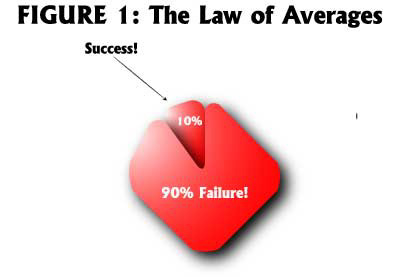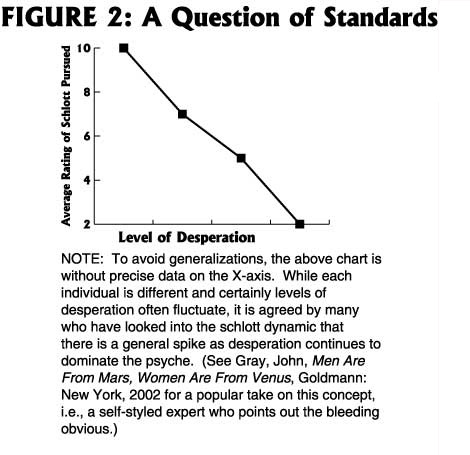 If, like me, you are a Single Bipedal and Sentient Mammal Over Thirty (to which I shall apply the term “schlott,” if only to abridge such a pesky mouthful to a clearly ridiculous and monosyllabic term), inevitably there comes a point where a certain fatigue sets in. Schlotts of all ages experience a certain malaise, not exactly a hopelessness per se, but a lengthy moment in which the warm, witty and wonderful entity that a schlott has established themselves to be is compromised by the fact that their warm, witty and wonderful advances are wholly incompatible (often mistakenly perceived as incorrigible) with the fellow schlotts they flirt with – in short, the act of being rebuffed despite multiple attempts. This is what’s known in the retail world as the law of averages: the expectation that 10% of everyone you pitch will in fact buy something (read: go out with you) regardless of what you have to say. (See Figure 1.)
If, like me, you are a Single Bipedal and Sentient Mammal Over Thirty (to which I shall apply the term “schlott,” if only to abridge such a pesky mouthful to a clearly ridiculous and monosyllabic term), inevitably there comes a point where a certain fatigue sets in. Schlotts of all ages experience a certain malaise, not exactly a hopelessness per se, but a lengthy moment in which the warm, witty and wonderful entity that a schlott has established themselves to be is compromised by the fact that their warm, witty and wonderful advances are wholly incompatible (often mistakenly perceived as incorrigible) with the fellow schlotts they flirt with – in short, the act of being rebuffed despite multiple attempts. This is what’s known in the retail world as the law of averages: the expectation that 10% of everyone you pitch will in fact buy something (read: go out with you) regardless of what you have to say. (See Figure 1.)
But what happens in the dating world, alas, is something more diabolical and complex. The law of averages does, in fact, apply. But what often happens is that, no matter how soundly hygienic, complimentary, scented, or scintillating you are, the fish, so to speak, often do not bite in any predetermined order. Meaning that it is possible for a schlott to flirt with 90 prospects, only to discover that the remaining 10% who will inevitably fall for the pitch, regardless of how frequently you flub your compliments or mangle your language (aided, no doubt, by nervousness and the ascension of intoxicants in some settings), resides at the end of the long and winding road. It is the inevitable moment of success which cannot be accounted for. Or the moment that arrives when a schlott finds someone, only to see his voicemails runneth over with other prospective ex-schlotts and somewhat embarrassed explanations to the compatible spirit and warm body who was kind and/or attracted enough to lie next to the initial schlott that the relationship is still nascent and exclusive, that there’s nothing here to worry about, and that the recently ex-schlott in question is the apple of the eye, the cat’s pajamas, the cream in the coffee, insert your affectionate term of art here.
But where the salesman often has a carefully selected list of leads at his disposal, the schlott, by contrast, only has eyes for the type of schlott he’d like to mate and cohabitate with at any particular moment. And his targets are often occluded by any number of failings (the amount of liquor imbibed, the veritable randiness which shows no sign of abating, and, in some schlotts, a telltale desperation) – in short, an arbitrary concern for aesthetics which often overrides the more common goal of finding someone nice to be with for a while or more.
 Indeed, with a schlott, there exists a certain question of standards. If the schlott has sufficiently rebounded and pulled his act together after a bad breakup, then initially these standards work against the law of averages, while simultaneously operating in tandem with them. This may sound somewhat self-defeating of my basic hypothesis, but allow me to explain. As Figure 2 illustrates, in the early stages, where the schlott has perched his head like an groundhog affably surveying his surroundings on February 2, he may feel initially quite confident, settling for only the very best (i.e., to carry the metaphor further, the lingering shadow of his confidence may in fact allow that initial drop between the 10 and the 7 to abstain from effect for about six weeks or so; this is assuming, of course, that the schlott does indeed see his shadow). But perhaps the groundhog…er…schlott is possessed of certain delusions of grandeur. Rising above and beyond the sensible all of realistic expectations, he looks only for the potential 10 and completely abandons the more reasonable 7.
Indeed, with a schlott, there exists a certain question of standards. If the schlott has sufficiently rebounded and pulled his act together after a bad breakup, then initially these standards work against the law of averages, while simultaneously operating in tandem with them. This may sound somewhat self-defeating of my basic hypothesis, but allow me to explain. As Figure 2 illustrates, in the early stages, where the schlott has perched his head like an groundhog affably surveying his surroundings on February 2, he may feel initially quite confident, settling for only the very best (i.e., to carry the metaphor further, the lingering shadow of his confidence may in fact allow that initial drop between the 10 and the 7 to abstain from effect for about six weeks or so; this is assuming, of course, that the schlott does indeed see his shadow). But perhaps the groundhog…er…schlott is possessed of certain delusions of grandeur. Rising above and beyond the sensible all of realistic expectations, he looks only for the potential 10 and completely abandons the more reasonable 7.
But in settling for the 10, the schlott precipitates his drop into the 2s. Because he is only setting himself up for disaster. Further, there is the question of whether the schlott’s overestimation of his own appeal may contribute to his decline and inevitable desperation. This certainly goes against the established law of averages. Thus, we have a situation in which the groundschlott should probably be more reasonable in his expectations or thus fall asunder.
But enough of these moribund dating projections! I am an uncredentialed scientist and I am already contemplating my own potential slide into the abyss. I blame the people who encouraged me to probe deeper into human coupling. And frankly, I try to leave my feelings out of these analyses. No doubt someone is having a laugh at my expense! Let us turn briefly then to the process of attraction.
 Figure 3 illustrates the importance of first impressions. In some cases, a schlott may approach another schlott and fail to consider that his aesthetics should be thoroughly optimized to ensure maximum conversational potential. If the schlott has had too much to drink or is allowing a minor depression or abstraction to interfere from his initial conversational approach (sometimes referred to as “a pickup line”), then his likelihood of meeting the schlott law of averages will dramatically decrease.
Figure 3 illustrates the importance of first impressions. In some cases, a schlott may approach another schlott and fail to consider that his aesthetics should be thoroughly optimized to ensure maximum conversational potential. If the schlott has had too much to drink or is allowing a minor depression or abstraction to interfere from his initial conversational approach (sometimes referred to as “a pickup line”), then his likelihood of meeting the schlott law of averages will dramatically decrease.
Such is considered the norm at any rate. But there are often fluke scenarios whereby the “bad” impression may in fact yield a positive outcome, particularly if the other schlott shares in common the abstraction, depression, or, most likely, a high inebriation level. Experts in schlott social dynamics often refer to this as “the drunken rebound one-night stand” or the “mercy fuck,” but, more often than not, the sheer preternatural outcome of it all cannot be appropriately accounted or tabulated, save through the carnal biological impulses embedded within schlotts (and often married bipedals) which cause them to consummate with anything that moves.
Indeed, it goes without saying that the schlott dilemma is an overlooked and often depressing subject to dwell upon. Which is why the Society to Further Schlottism has asked me to not only produce these statistics, but provide a rosy bow with which to wrap this informational bauble. Yes, human beings need to procreate. Yes, they need companionship and affection. Yes, they need to break out of the misanthropic isolation chronicled in Mr. Putnam’s book, Bowling Alone. But for the schlott who is inhabiting the lower-right hand area of Figure 2, we have one bona-fide piece of advice to offer: Never underestimate the immediate benefits of masturbation. Also, if it’s time to lean, it’s time to clean.
(NOTE: This study has been paid for by the Society to Further Schlottism, in collusion with a grant from the Department of Half-Baked Empirical Research.)
Hey, my name is Schlotts!